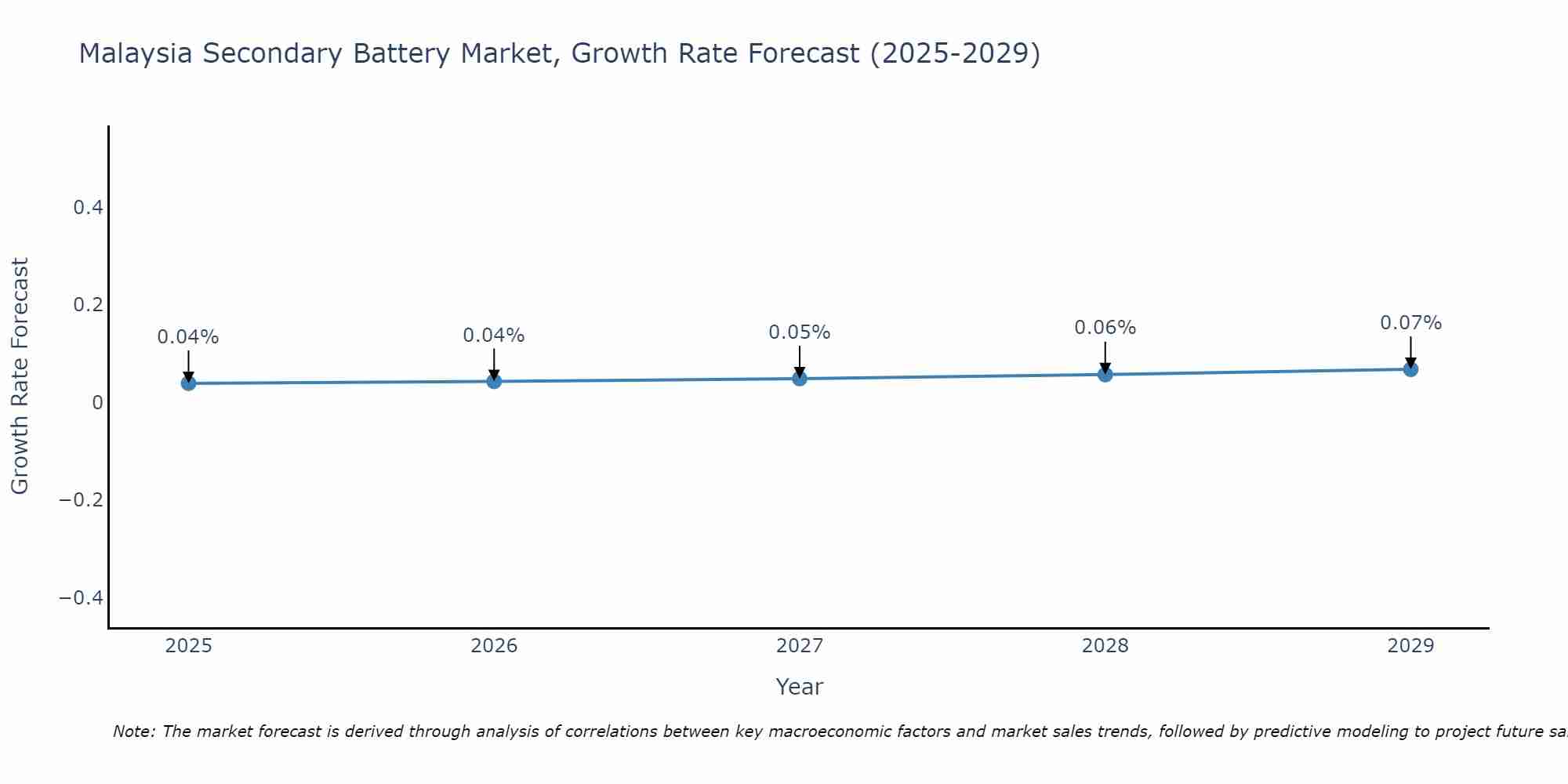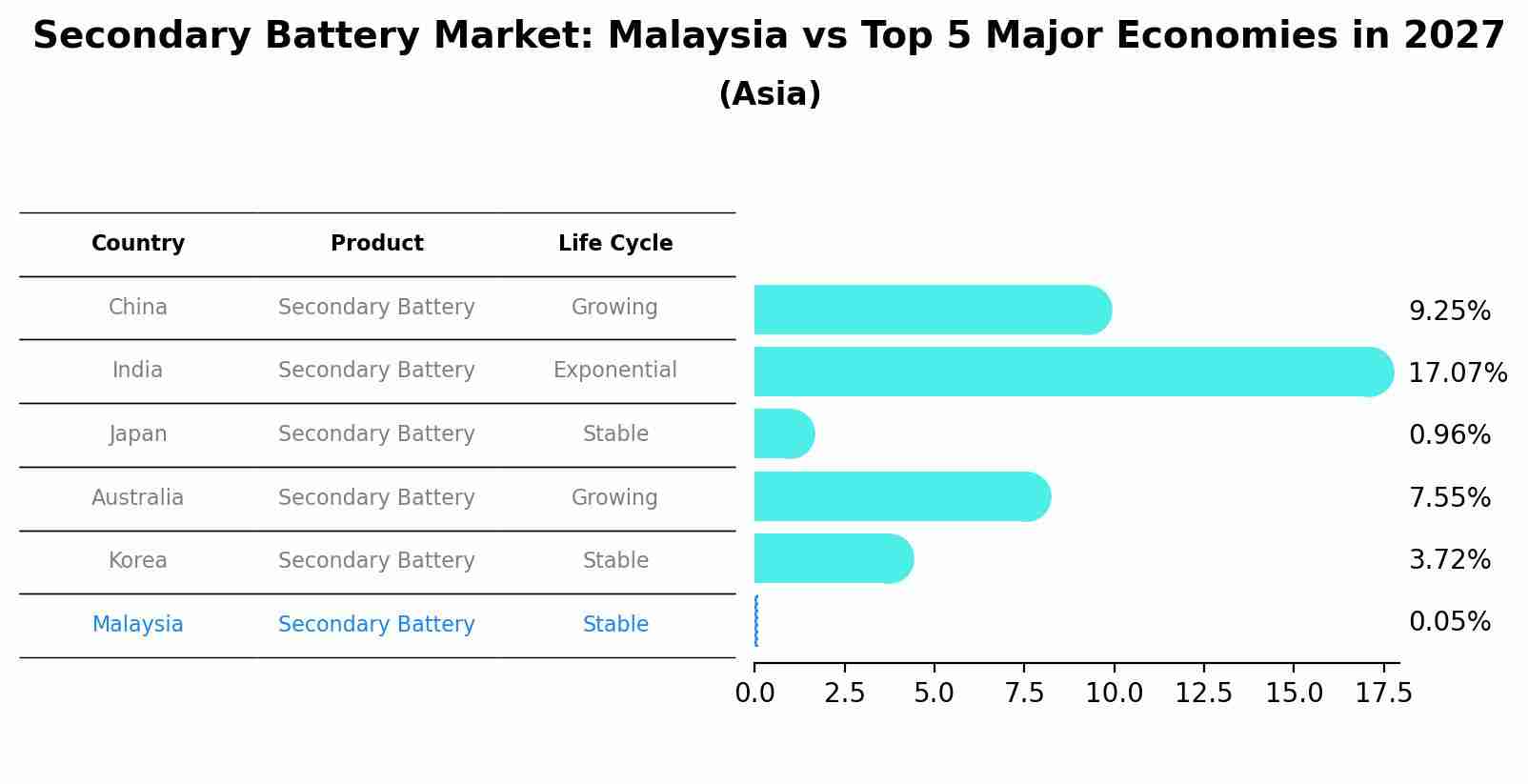Malaysia Secondary Battery Market (2025-2031) Outlook | Share, Companies, Revenue, Forecast, Trends, Value, Size, Growth, Analysis & Industry
| Product Code: ETC270446 | Publication Date: Aug 2022 | Updated Date: Apr 2025 | Product Type: Market Research Report | |
| Publisher: 6Wresearch | No. of Pages: 75 | No. of Figures: 35 | No. of Tables: 20 | |
Malaysia Secondary Battery Market Size Growth Rate
The Malaysia Secondary Battery Market is likely to experience consistent growth rate gains over the period 2025 to 2029. Commencing at 0.04% in 2025, growth builds up to 0.07% by 2029.

Secondary Battery Market: Malaysia vs Top 5 Major Economies in 2027 (Asia)
The Secondary Battery market in Malaysia is projected to grow at a stable growth rate of 0.05% by 2027, highlighting the country's increasing focus on advanced technologies within the Asia region, where China holds the dominant position, followed closely by India, Japan, Australia and South Korea, shaping overall regional demand.

Malaysia Secondary Battery Market Synopsis
The Malaysia secondary battery market encompasses rechargeable batteries used in various applications, including consumer electronics, electric vehicles, and renewable energy storage. As Malaysia explores renewable energy options and encourages electric vehicle adoption, the demand for secondary batteries, such as lithium-ion batteries, is projected to increase significantly.
Drivers of the Market
The secondary battery market in Malaysia is poised for growth, primarily driven by the adoption of electric vehicles (EVs) and the increasing use of energy storage systems (ESS) in various applications. Government incentives and policies supporting EVs and renewable energy are expected to fuel the demand for secondary batteries. Additionally, the rising awareness of environmental sustainability is driving the market for rechargeable batteries in consumer electronics and industrial sectors.
Challenges of the Market
The secondary battery market in Malaysia confronts challenges related to sustainability and environmental concerns. Increasing awareness of the environmental impact of battery production and disposal has led to stricter regulations and demands for eco-friendly alternatives. Competition from global battery manufacturers can also affect local players. Securing a sustainable supply chain for raw materials, particularly rare earth elements, can be a significant challenge. Moreover, achieving higher energy density, longer lifespan, and faster charging capabilities while maintaining affordability is an ongoing challenge for battery manufacturers.
COVID 19 Impact on the Market
The secondary battery market in Malaysia experienced mixed effects due to the pandemic. Initially, disruptions in the global supply chain impacted the availability of raw materials and components needed for battery production. However, as remote work and online activities surged, the demand for electronic devices and storage solutions increased. This subsequently drove the demand for secondary batteries used in laptops, tablets, and smartphones. Manufacturers adapted to these changing dynamics, and the market showed resilience and growth.
Key Players in the Market
Leading players in the Malaysia secondary battery market encompass Panasonic Corporation, Samsung SDI Co., Ltd., LG Chem Ltd., Sony Corporation, and BYD Company Limited. These companies manufacture a wide range of secondary batteries, including lithium-ion batteries, for various applications.
Key Highlights of the Report:
- Malaysia Secondary Battery Market Outlook
- Market Size of Malaysia Secondary Battery Market, 2024
- Forecast of Malaysia Secondary Battery Market, 2031
- Historical Data and Forecast of Malaysia Secondary Battery Revenues & Volume for the Period 2021-2031
- Malaysia Secondary Battery Market Trend Evolution
- Malaysia Secondary Battery Market Drivers and Challenges
- Malaysia Secondary Battery Price Trends
- Malaysia Secondary Battery Porter's Five Forces
- Malaysia Secondary Battery Industry Life Cycle
- Historical Data and Forecast of Malaysia Secondary Battery Market Revenues & Volume By Technology for the Period 2021-2031
- Historical Data and Forecast of Malaysia Secondary Battery Market Revenues & Volume By Lead-acid Battery for the Period 2021-2031
- Historical Data and Forecast of Malaysia Secondary Battery Market Revenues & Volume By Lithium-ion Battery for the Period 2021-2031
- Historical Data and Forecast of Malaysia Secondary Battery Market Revenues & Volume By Other Technologies (NiMh, NiCD, etc.) for the Period 2021-2031
- Historical Data and Forecast of Malaysia Secondary Battery Market Revenues & Volume By Application for the Period 2021-2031
- Historical Data and Forecast of Malaysia Secondary Battery Market Revenues & Volume By Automotive Batteries (HEV, PHEV, and EV) for the Period 2021-2031
- Historical Data and Forecast of Malaysia Secondary Battery Market Revenues & Volume By Industrial Batteries (Motive, Stationary (Telecom, UPS, Energy Storage Systems (ESS), etc.) for the Period 2021-2031
- Historical Data and Forecast of Malaysia Secondary Battery Market Revenues & Volume By Portable Batteries (Consumer Electronics, etc.) for the Period 2021-2031
- Historical Data and Forecast of Malaysia Secondary Battery Market Revenues & Volume By Other Applications for the Period 2021-2031
- Malaysia Secondary Battery Import Export Trade Statistics
- Market Opportunity Assessment By Technology
- Market Opportunity Assessment By Application
- Malaysia Secondary Battery Top Companies Market Share
- Malaysia Secondary Battery Competitive Benchmarking By Technical and Operational Parameters
- Malaysia Secondary Battery Company Profiles
- Malaysia Secondary Battery Key Strategic Recommendations
Frequently Asked Questions About the Market Study (FAQs):
1 Executive Summary |
2 Introduction |
2.1 Key Highlights of the Report |
2.2 Report Description |
2.3 Market Scope & Segmentation |
2.4 Research Methodology |
2.5 Assumptions |
3 Malaysia Secondary Battery Market Overview |
3.1 Malaysia Country Macro Economic Indicators |
3.2 Malaysia Secondary Battery Market Revenues & Volume, 2021 & 2031F |
3.3 Malaysia Secondary Battery Market - Industry Life Cycle |
3.4 Malaysia Secondary Battery Market - Porter's Five Forces |
3.5 Malaysia Secondary Battery Market Revenues & Volume Share, By Technology, 2021 & 2031F |
3.6 Malaysia Secondary Battery Market Revenues & Volume Share, By Application, 2021 & 2031F |
4 Malaysia Secondary Battery Market Dynamics |
4.1 Impact Analysis |
4.2 Market Drivers |
4.3 Market Restraints |
5 Malaysia Secondary Battery Market Trends |
6 Malaysia Secondary Battery Market, By Types |
6.1 Malaysia Secondary Battery Market, By Technology |
6.1.1 Overview and Analysis |
6.1.2 Malaysia Secondary Battery Market Revenues & Volume, By Technology, 2021-2031F |
6.1.3 Malaysia Secondary Battery Market Revenues & Volume, By Lead-acid Battery, 2021-2031F |
6.1.4 Malaysia Secondary Battery Market Revenues & Volume, By Lithium-ion Battery, 2021-2031F |
6.1.5 Malaysia Secondary Battery Market Revenues & Volume, By Other Technologies (NiMh, NiCD, etc.), 2021-2031F |
6.2 Malaysia Secondary Battery Market, By Application |
6.2.1 Overview and Analysis |
6.2.2 Malaysia Secondary Battery Market Revenues & Volume, By Automotive Batteries (HEV, PHEV, and EV), 2021-2031F |
6.2.3 Malaysia Secondary Battery Market Revenues & Volume, By Industrial Batteries (Motive, Stationary (Telecom, UPS, Energy Storage Systems (ESS), etc.), 2021-2031F |
6.2.4 Malaysia Secondary Battery Market Revenues & Volume, By Portable Batteries (Consumer Electronics, etc.), 2021-2031F |
6.2.5 Malaysia Secondary Battery Market Revenues & Volume, By Other Applications, 2021-2031F |
7 Malaysia Secondary Battery Market Import-Export Trade Statistics |
7.1 Malaysia Secondary Battery Market Export to Major Countries |
7.2 Malaysia Secondary Battery Market Imports from Major Countries |
8 Malaysia Secondary Battery Market Key Performance Indicators |
9 Malaysia Secondary Battery Market - Opportunity Assessment |
9.1 Malaysia Secondary Battery Market Opportunity Assessment, By Technology, 2021 & 2031F |
9.2 Malaysia Secondary Battery Market Opportunity Assessment, By Application, 2021 & 2031F |
10 Malaysia Secondary Battery Market - Competitive Landscape |
10.1 Malaysia Secondary Battery Market Revenue Share, By Companies, 2024 |
10.2 Malaysia Secondary Battery Market Competitive Benchmarking, By Operating and Technical Parameters |
11 Company Profiles |
12 Recommendations |
13 Disclaimer |
- Single User License$ 1,995
- Department License$ 2,400
- Site License$ 3,120
- Global License$ 3,795
Search
Related Reports
- Saudi Arabia Manlift Market (2025-2031) | Outlook, Size, Growth, Trends, Companies, Industry, Revenue, Value, Share, Forecast & Analysis
- Uganda Excavator, Crane, and Wheel Loaders Market (2025-2031) | Strategy, Consumer Insights, Analysis, Investment Trends, Opportunities, Growth, Size, Share, Industry, Revenue, Segments, Value, Segmentation, Supply, Forecast, Restraints, Outlook, Competition, Drivers, Trends, Demand, Pricing Analysis, Competitive, Strategic Insights, Companies, Challenges
- Rwanda Excavator, Crane, and Wheel Loaders Market (2025-2031) | Strategy, Consumer Insights, Analysis, Investment Trends, Opportunities, Growth, Size, Share, Industry, Revenue, Segments, Value, Segmentation, Supply, Forecast, Restraints, Outlook, Competition, Drivers, Trends, Demand, Pricing Analysis, Competitive, Strategic Insights, Companies, Challenges
- Kenya Excavator, Crane, and Wheel Loaders Market (2025-2031) | Strategy, Consumer Insights, Analysis, Investment Trends, Opportunities, Growth, Size, Share, Industry, Revenue, Segments, Value, Segmentation, Supply, Forecast, Restraints, Outlook, Competition, Drivers, Trends, Demand, Pricing Analysis, Competitive, Strategic Insights, Companies, Challenges
- Angola Excavator, Crane, and Wheel Loaders Market (2025-2031) | Strategy, Consumer Insights, Analysis, Investment Trends, Opportunities, Growth, Size, Share, Industry, Revenue, Segments, Value, Segmentation, Supply, Forecast, Restraints, Outlook, Competition, Drivers, Trends, Demand, Pricing Analysis, Competitive, Strategic Insights, Companies, Challenges
- Israel Intelligent Transport System Market (2025-2031) | Strategy, Consumer Insights, Analysis, Investment Trends, Opportunities, Growth, Size, Share, Industry, Revenue, Segments, Value, Segmentation, Supply, Forecast, Restraints, Outlook, Competition, Drivers, Trends, Demand, Pricing Analysis, Competitive, Strategic Insights, Companies, Challenges
- Uganda Precast and Aggregate Market (2025-2031) | Strategy, Consumer Insights, Analysis, Investment Trends, Opportunities, Growth, Size, Share, Industry, Revenue, Segments, Value, Segmentation, Supply, Forecast, Restraints, Outlook, Competition, Drivers, Trends, Demand, Pricing Analysis, Competitive, Strategic Insights, Companies, Challenges
- Australia IT Asset Disposal Market (2025-2031) | Strategy, Consumer Insights, Analysis, Investment Trends, Opportunities, Growth, Size, Share, Industry, Revenue, Segments, Value, Segmentation, Supply, Forecast, Restraints, Outlook, Competition, Drivers, Trends, Demand, Pricing Analysis, Competitive, Strategic Insights, Companies, Challenges
- UAE Building Thermal Insulation Market Outlook (2025-2031) | Revenue, Companies, Share, Trends, Growth, Size, Forecast, Industry, Analysis & Value
- Portugal Electronic Document Management Market (2025-2031) | Strategy, Consumer Insights, Analysis, Investment Trends, Opportunities, Growth, Size, Share, Industry, Revenue, Segments, Value, Segmentation, Supply, Forecast, Restraints, Outlook, Competition, Drivers, Trends, Demand, Pricing Analysis, Competitive, Strategic Insights, Companies, Challenges
Industry Events and Analyst Meet
Our Clients
Whitepaper
- Middle East & Africa Commercial Security Market Click here to view more.
- Middle East & Africa Fire Safety Systems & Equipment Market Click here to view more.
- GCC Drone Market Click here to view more.
- Middle East Lighting Fixture Market Click here to view more.
- GCC Physical & Perimeter Security Market Click here to view more.
6WResearch In News
- Doha a strategic location for EV manufacturing hub: IPA Qatar
- Demand for luxury TVs surging in the GCC, says Samsung
- Empowering Growth: The Thriving Journey of Bangladesh’s Cable Industry
- Demand for luxury TVs surging in the GCC, says Samsung
- Video call with a traditional healer? Once unthinkable, it’s now common in South Africa
- Intelligent Buildings To Smooth GCC’s Path To Net Zero













